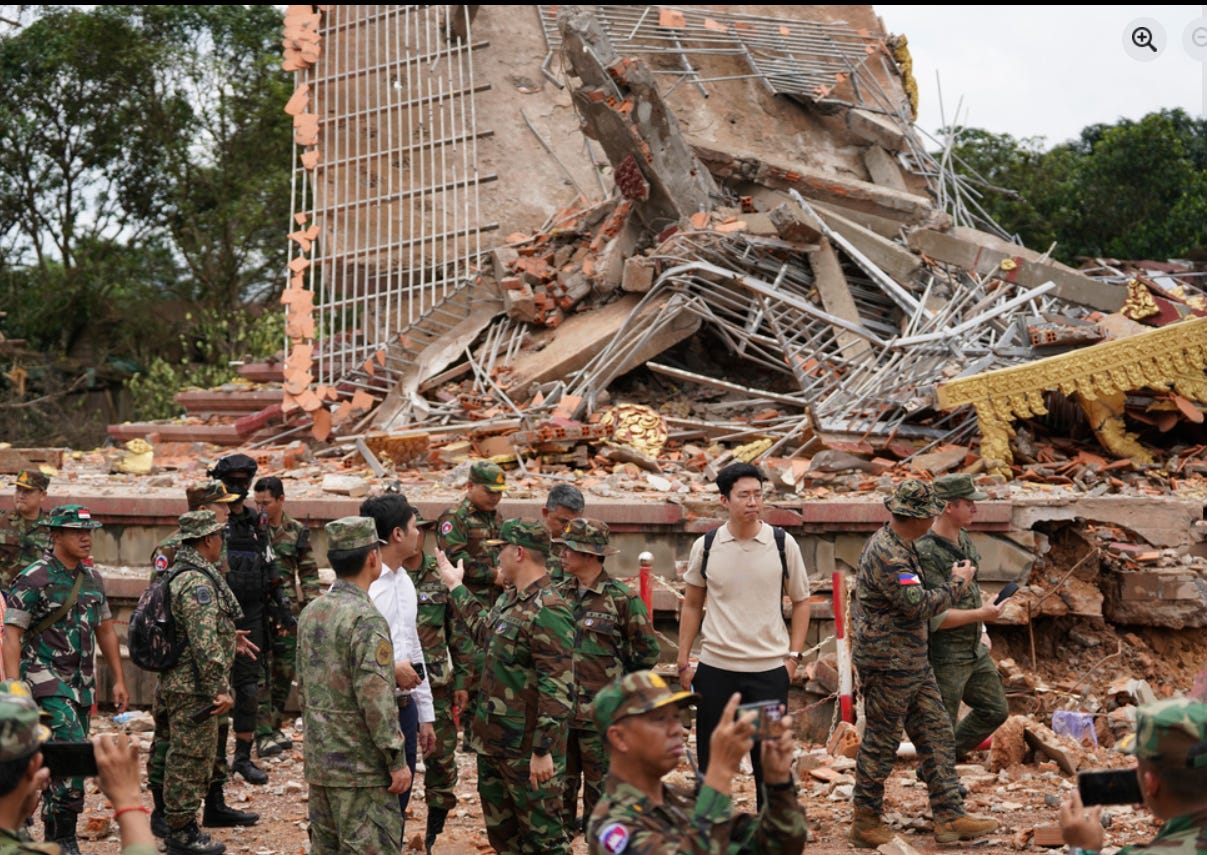
Murray Hunter
Aftermath of Thai-Cambodian border ceasefire
Jul 31, 2025

We are now three days into the Thai-Cambodian ceasefire agreed to in Putra Jaya on July 28. Fighting did cease at 12.00 AM on Tuesday morning, with only a few hiccups. The Thai and Cambodian forces fought very hard during the last few hours before the cease fire to consolidate their geographical positions.
Nevertheless, there were a few minor skirmishes until the morning, when Thai and Cambodian army commanders met in two places along the border to coordinate the ceasefire. A small number of ceasefire observers from the Malaysian army, led by General Mohammad Nizam Jaafar, had arrived to coordinate the ceasefire and place an ASEAN observer team along the border.
However, on Tuesday night around 30 drones were seen flying over Ubom Ratchathani Airport, where the Thai F-16s have been stationed throughout the conflict. There were a number of reports claiming small arms and grenade clashes at Chong An Ma and Phu Makheau. The Thais retaliated against the Cambodian forces to retake Chong An Ma, which has been met with diplomatic protests on both sides.
The Thai army alleged that 18 Cambodian soldiers surrendered to Thai forces after the ceasefire, and Cambodia is making diplomatic efforts for their return to Cambodia.
One of the major post ceasefire issues is the close proximity of Thai and Cambodian forces due to poor demarcation of the Thai-Cambodia border. Thai forces have erected temporary barriers around Ta Muen Thom temple to separate the two forces.
Aftermath
There appears to be a general peace along the border area, although more than 140,000 displaced Thai and Cambodians have been very slow to return to their homes. It appears authorities on both sides haven’t directed locals in halls and temples to return home as yet. On the Thai side, other than army and government traffic, there is virtually no general traffic on the highways heading towards the borders from cities like Surin and Sisaket. Some military units have been seen travelling across Thailand towards the Thai-Cambodian border areas.
As borders are still closed, there is almost zero border trade, which is an important aspect of both local economies. To the locals any ceasefire without reopened borders means very little. Cambodians on the Thai side who still wish to be repatriated, are moving at a very slow pace, as immigration and labour offices are only open spasmodically.
Bloomberg stated that the United States had just reached a tariff deal with both Thailand and Cambodia, ahead of the August 1 deadline. Both Thailand and Cambodia would have faced a 36 percent tariff rate on goods entering the US starting August 1, but it is believed the new tariff rate will be around 19-20 percent. Some believe that the threat by US President Trump to postpone tariff discussions if there was no ceasefire was a major carrot for both parties.
Others believe that the ceasefire presided over by the ASEAN Chair Malaysia has been a good boost to the integrity of the Association. Malaysia is also hoping that it will be rewarded for its mediation role in the ceasefire by Trump, with a lower tariff rate. However, for ASEAN the ‘devil will be in the detail’, with the negotiation of a longtime truce.
It will be very difficult for ASEAN negotiators to intervene upon the personalities behind the fighting. Hun Sen and Thaksin Shinawatra have personal issues that no one currently understands. Secondly, there are a number of ‘mafia’, and ‘mob’ groups well connected with Hun Sen who want some retribution against the Thai army for targeting their scam, money laundering and casino operations along the border.
Much of South East Asia is influenced by a relatively small number of families, which must be taken account of in formulating any long-term truce. This could be an issue ASEAN cannot grapple with in developing any long-term solution.
The major winner of the Thai-Cambodian border conflict is China. Chinese influence within Cambodia is massive. Much Cambodian development has been based upon Chinese money. The Ream Naval Base on the Cambodian coast not far from Phnom Penh is being expanded by the Chinese, making it suitable for military use. The base is strategically located in the Gulf of Thailand, with direct access to the South China Sea.
Currently, the base is a joint Cambodian-Chinese facility. However, there is every incentive for Cambodia to encourage China to maximize its presence on the base. For China, the Ream Naval Base can tip primacy towards China in the region. Any strong Chinese military presence within Cambodia could become an important future military deterrent in the future.
Never Trust the Khmer Rouge. Hun Sen was and is a Khmer Rouge soldier.
ReplyDeleteDuring the Khmer Rouge regime, Hun Sen served as a Battalion Commander in the Eastern Region. He led a force of around 2,000 men.
Human Rights Watch suggested he may have had a role in a massacre to suppress Cham Muslim unrest in September–October 1975. When it became clear that the Khmer Rouge would be routed by the Vietnamese he switched sides.
Following the defeat of the Khmer Rouge regime, Hun Sen was appointed as Deputy Prime Minister and Foreign Minister of the Vietnamese-installed People's Republic of Kampuchea/State of Cambodia (PRK/SOC) in 1979 at age 26. He the became PM in 1985.